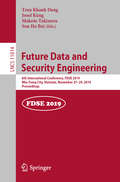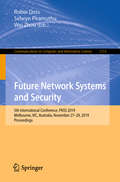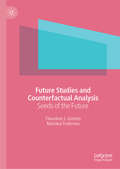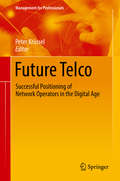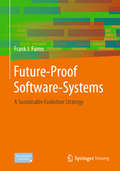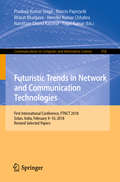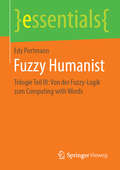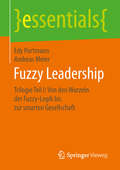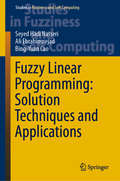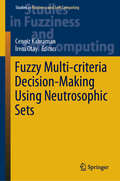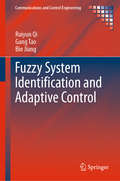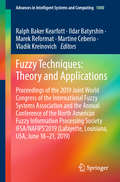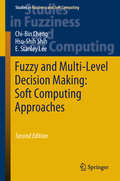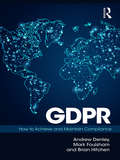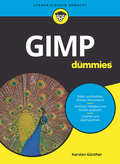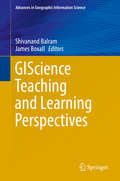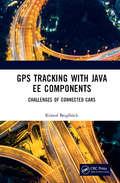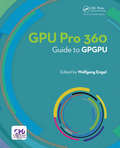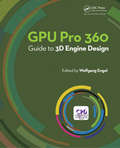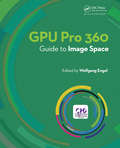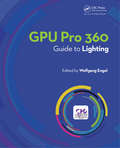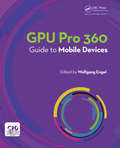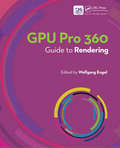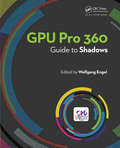- Table View
- List View
Future Data and Security Engineering: 6th International Conference, FDSE 2019, Nha Trang City, Vietnam, November 27–29, 2019, Proceedings (Lecture Notes in Computer Science #11814)
by Josef Küng Tran Khanh Dang Makoto Takizawa Son Ha BuiThis book constitutes the proceedings of the 6th International Conference on Future Data and Security Engineering, FDSE 2019, held in Nha Trang City, Vietnam, in November 2019.The 38 full papers and 14 short papers presented together with 2 papers of keynote speeches were carefully reviewed and selected from 159 submissions. The selected papers are organized into the following topical headings: Invited Keynotes, Advanced Studies in Machine Learning, Advances in Query Processing and Optimization, Big Data Analytics and Distributed Systems, Deep Learning and Applications, Cloud Data Management and Infrastructure, Security and Privacy Engineering, Authentication and Access Control, Blockchain and Cybersecurity, Emerging Data Management Systems and Applications, Short papers: Security and Data Engineering.
Future Network Systems and Security: 5th International Conference, FNSS 2019, Melbourne, VIC, Australia, November 27–29, 2019, Proceedings (Communications in Computer and Information Science #1113)
by Selwyn Piramuthu Robin Doss Wei ZhouThis book constitutes the refereed proceedings of the 5th International Conference on Future Network Systems and Security, FNSS 2019, held in Melbourne, Australia, in November 2019. The 16 full papers and two short papers presented were carefully reviewed and selected from 38 submissions. The papers are organized in topical sections onemerging networks and applications; security, privacy and trust; and security analytics and forensics
Future Studies and Counterfactual Analysis: Seeds of the Future
by Theodore J. Gordon Mariana TodorovaIn this volume, the authors contribute to futures research by placing the counterfactual question in the future tense. They explore the possible outcomes of future, and consider how future decisions are turning points that may produce different global outcomes. This book focuses on a dozen or so intractable issues that span politics, religion, and technology, each addressed in individual chapters. Until now, most scenarios written by futurists have been built on cause and effect narratives or depended on numerical models derived from historical relationships. In contrast, many of the scenarios written for this book are point descriptions of future discontinuities, a form allows more thought-provoking presentations. Ultimately, this book demonstrates that counterfactual thinking and point scenarios of discontinuities are new, groundbreaking tools for futurists.
Future Telco: Successful Positioning of Network Operators in the Digital Age (Management for Professionals)
by Peter KrüsselThis book examines the extensive changes in markets, technologies and value chains that telecommunication companies are currently confronted with. It analyzes the crossroads they have reached and the choices that now need to be made – to be a bit pipe or a trendsetter of digitalization. Based on an analysis of the key challenges for telcos, the book derives future market scenarios and puts forward recommendations for how they can successfully position themselves. It proposes a framework based on seven “levers,” which addresses concrete measures in each step of the value chain, ranging from technology, IT and processes, to innovation, marketing and sales issues. The book discusses the current challenges and provides both general recommendations and concrete solutions. Respected experts illustrate innovative strategic and technical trends and provide insights gained in real-life transformation projects. Recent developments in the areas of regulation, product development, competition between over-the-top (OTT) providers and telcos, as well as technical innovations like 5G, SDN/NFV, LEO satellites and MEC are discussed. Accordingly, practitioners, managers and researchers alike will benefit from the book’s wealth of examples and up-to-date insights.
Future-Proof Software-Systems: A Sustainable Evolution Strategy
by Frank J. FurrerThis book focuses on software architecture and the value of architecture in the development of long-lived, mission-critical, trustworthy software-systems. The author introduces and demonstrates the powerful strategy of “Managed Evolution,” along with the engineering best practice known as “Principle-based Architecting.” The book examines in detail architecture principles for e.g., Business Value, Changeability, Resilience, and Dependability. The author argues that the software development community has a strong responsibility to produce and operate useful, dependable, and trustworthy software. Software should at the same time provide business value and guarantee many quality-of-service properties, including security, safety, performance, and integrity. As Dr. Furrer states, “Producing dependable software is a balancing act between investing in the implementation of business functionality and investing in the quality-of-service properties of the software-systems.” The book presents extensive coverage of such concepts as: Principle-Based Architecting Managed Evolution StrategyThe Future Principles for Business Value Legacy Software Modernization/Migration Architecture Principles for Changeability Architecture Principles for Resilience Architecture Principles for Dependability The text is supplemented with numerous figures, tables, examples and illustrative quotations. Future-Proof Software-Systems provides a set of good engineering practices, devised for integration into most software development processes dedicated to the creation of software-systems that incorporate Managed Evolution.
Futuristic Trends in Network and Communication Technologies: First International Conference, FTNCT 2018, Solan, India, February 9–10, 2018, Revised Selected Papers (Communications in Computer and Information Science #958)
by Pradeep Kumar Singh Marcin Paprzycki Bharat Bhargava Jitender Kumar Chhabra Narottam Chand Kaushal Yugal KumarThis book constitutes the refereed proceedings of the First International Conference on Futuristic Trends in Network and Communication Technologies, FTNCT 2018, held in Solan, India, in February 2018. The 37 revised full papers presented were carefully reviewed and selected from 239 submissions. The prime aim of the conference is to invite researchers from different domains of network and communication technologies to a single platform to showcase their research ideas. The selected papers are organized in topical sections on communication technologies, Internet of Things (IoT), network technologies, and wireless networks.
Fuzzy Humanist: Trilogie Teil III: Von der Fuzzy-Logik zum Computing with Words (essentials)
by Edy PortmannAuch mit Worten, Phrasen, Präpositionen, Fragen sowie anderen semantischen Einheiten der natürlichen Sprache ist es möglich, zu rechnen. Daher ist diese Methode für einen Einsatz im Sinne des Humanismus prädestiniert. Edy Portmann erläutert den Zusammenhang von Fuzzy-Logik und dem Rechnen mit Worten und zeigt daran den Unterschied zwischen heutigen Suchmaschinen sowie zukünftigen Frage-Antwort-Systemen auf. Er legt dar, wie das Rechnen mit Worten als Grundlage einer Mensch-Maschine-Symbiose dient, die in kollektiver (urbaner) Intelligenz mündet. Als Ausblick weist der Autor darauf hin, wie Computing with Words zur Schaffung von kollektiver Intelligenz beitragen kann.Der Autor:Prof. Dr. Edy Portmann ist Swiss Post Professor of Computer Science am Human-IST Institut der Universität Fribourg, Schweiz. In seiner Forschung beschäftigt er sich mit Fragen rund um Informationssysteme, -verarbeitung und -beschaffung.
Fuzzy Leadership: Trilogie Teil I: Von den Wurzeln der Fuzzy-Logik bis zur smarten Gesellschaft (essentials)
by Edy Portmann Andreas MeierDie unscharfe Logik (Fuzzy Logic) erweitert die klassische Logik, indem neben den beiden Wahrheitswerten 1 für ‚wahr’ und 0 für ‚falsch’ alle Werte des Einheitsintervalls zugelassen sind. Die unscharfe Logik entspricht der menschlichen Wahrnehmung, da sie unsichere Sachverhalte oder vage Aussagen in einem Entscheidungsprozess mitberücksichtigt. Edy Portmann und Andreas Meier geben in diesem essential über Fuzzy Leadership einen Überblick zu Grundlagen der unscharfen Logik und zeigen das Potenzial in unterschiedlichen Anwendungen der digitalen Wirtschaft sowie in der Informations- und Wissensgesellschaft auf. Die Autoren:Prof. Dr. Edy Portmann ist Swiss Post Professor of Computer Science am Human-IST Institut der Universität Fribourg, Schweiz. In seiner Forschung beschäftigt er sich mit Fragen rund um Informationssysteme, -verarbeitung und -beschaffung. Prof. Dr. Andreas Meier leitete in den Jahren 1999 bis 2018 den Lehrstuhl für Wirtschaftsinformatik an der Universität Fribourg, Schweiz. Seine Forschungsgebiete waren eBusiness, eGovernment und Informationsmanagement.
Fuzzy Linear Programming: Solution Techniques and Applications (Studies in Fuzziness and Soft Computing #379)
by Bing-Yuan Cao Ali Ebrahimnejad Seyed Hadi NasseriThis book presents the necessary and essential backgrounds of fuzzy set theory and linear programming, particularly a broad range of common Fuzzy Linear Programming (FLP) models and related, convenient solution techniques. These models and methods belong to three common classes of fuzzy linear programming, namely: (i) FLP problems in which all coefficients are fuzzy numbers, (ii) FLP problems in which the right-hand-side vectors and the decision variables are fuzzy numbers, and (iii) FLP problems in which the cost coefficients, the right-hand-side vectors and the decision variables are fuzzy numbers. The book essentially generalizes the well-known solution algorithms used in linear programming to the fuzzy environment. Accordingly, it can be used not only as a textbook, teaching material or reference book for undergraduate and graduate students in courses on applied mathematics, computer science, management science, industrial engineering, artificial intelligence, fuzzy information processes, and operations research, but can also serve as a reference book for researchers in these fields, especially those engaged in optimization and soft computing. For textbook purposes, it also includes simple and illustrative examples to help readers who are new to the field.
Fuzzy Multi-criteria Decision-Making Using Neutrosophic Sets
by Cengiz Kahraman İrem OtayThis book offers a comprehensive guide to the use of neutrosophic sets in multiple criteria decision making problems. It shows how neutrosophic sets, which have been developed as an extension of fuzzy and paraconsistent logic, can help in dealing with certain types of uncertainty that classical methods could not cope with. The chapters, written by well-known researchers, report on cutting-edge methodologies they have been developing and testing on a variety of engineering problems. The book is unique in its kind as it reports for the first time and in a comprehensive manner on the joint use of neutrosophic sets together with existing decision making methods to solve multi-criteria decision-making problems, as well as other engineering problems that are complex, hard to model and/or include incomplete and vague data. By providing new ideas, suggestions and directions for the solution of complex problems in engineering and decision making, it represents an excellent guide for researchers, lecturers and postgraduate students pursuing research on neutrosophic decision making, and more in general in the area of industrial and management engineering.
Fuzzy System Identification and Adaptive Control (Communications and Control Engineering)
by Bin Jiang Ruiyun Qi Gang TaoThis book provides readers with a systematic and unified framework for identification and adaptive control of Takagi–Sugeno (T–S) fuzzy systems. Its design techniques help readers applying these powerful tools to solve challenging nonlinear control problems. The book embodies a systematic study of fuzzy system identification and control problems, using T–S fuzzy system tools for both function approximation and feedback control of nonlinear systems. Alongside this framework, the book also: introduces basic concepts of fuzzy sets, logic and inference system; discusses important properties of T–S fuzzy systems; develops offline and online identification algorithms for T–S fuzzy systems; investigates the various controller structures and corresponding design conditions for adaptive control of continuous-time T–S fuzzy systems; develops adaptive control algorithms for discrete-time input–output form T–S fuzzy systems with much relaxed design conditions, and discrete-time state-space T–S fuzzy systems; and designs stable parameter-adaptation algorithms for both linearly and nonlinearly parameterized T–S fuzzy systems. The authors address adaptive fault compensation problems for T–S fuzzy systems subject to actuator faults. They cover a broad spectrum of related technical topics and to develop a substantial set of adaptive nonlinear system control tools. Fuzzy System Identification and Adaptive Control helps engineers in the mechanical, electrical and aerospace fields, to solve complex control design problems. The book can be used as a reference for researchers and academics in nonlinear, intelligent, adaptive and fault-tolerant control.
Fuzzy Techniques: Proceedings of the 2019 Joint World Congress of the International Fuzzy Systems Association and the Annual Conference of the North American Fuzzy Information Processing Society IFSA/NAFIPS'2019 (Lafayette, Louisiana, USA, June 18–21, 2019) (Advances in Intelligent Systems and Computing #1000)
by Vladik Kreinovich Martine Ceberio Marek Reformat Ildar Batyrshin Ralph Baker KearfottThis book describes the latest findings related to fuzzy techniques, discussing applications in control, economics, education, humor studies, industrial engineering, linguistics, management, marketing, medicine and public health, military engineering, robotics, ship design, sports, transportation, and many other areas. It also presents recent fuzzy-related algorithms and theoretical results that can be used in other application areas. Featuring selected papers from the Joint World Congress of the International Fuzzy Systems Association (IFSA) and the Annual Conference of the North American Fuzzy Information Processing Society (NAFIPS) IFSA-NAFIPS’2019, held in Lafayette, Louisiana, USA, on June 18–21, 2019, the book is of interest to practitioners wanting to use fuzzy techniques to process imprecise expert knowledge. It is also a valuable resource for researchers wishing to extend the ideas from these papers to new application areas, for graduate students and for anyone else interested in problems involving fuzziness and uncertainty.
Fuzzy and Multi-Level Decision Making: Soft Computing Approaches (Studies in Fuzziness and Soft Computing #368)
by Chi-Bin Cheng Hsu-Shih Shih E. Stanley LeeThis book offers a comprehensive overview of cutting-edge approaches for decision-making in hierarchical organizations. It presents soft-computing-based techniques, including fuzzy sets, neural networks, genetic algorithms and particle swarm optimization, and shows how these approaches can be effectively used to deal with problems typical of this kind of organization. After introducing the main classical approaches applied to multiple-level programming, the book describes a set of soft-computing techniques, demonstrating their advantages in providing more efficient solutions to hierarchical decision-making problems compared to the classical methods. Based on the book Fuzzy and Multi-Level Decision Making (Springer, 2001) by Lee E.S and Shih, H., this second edition has been expanded to include the most recent findings and methods and a broader spectrum of soft computing approaches. All the algorithms are presented in detail, together with a wealth of practical examples and solutions to real-world problems, providing students, researchers and professionals with a timely, practice-oriented reference guide to the area of interactive fuzzy decision making, multi-level programming and hierarchical optimization.
GDPR: How To Achieve and Maintain Compliance
by Mark Foulsham Brian Hitchen Andrew DenleyFollowing the implementation of the new General Data Protect Regulation on 25 May 2018, organizations should now be fully compliant with their national interpretation of this far-reaching data protection standard. The reality is that most are not; whether through their inappropriate use of online cookies or ineffective physical data security, businesses continue to struggle with the increasing pressure from regulators to apply the Regulation. Non-compliance is widely due to misinterpretation, lack of real-world thinking, and challenges in balancing costs against business practicalities. This book provides insight into how to achieve effective compliance in a realistic, no-nonsense and efficient way. The authors have over 100 years’ collective international experience in security, compliance and business disciplines and know what it takes to keep companies secure and in-line with regulators’ demands. Whether your organization needs to swiftly adopt GDPR standards or apply them in “Business as Usual” this book provides a wide range of recommendations and explicit examples. With the likelihood of high-profile penalties causing major reputational damage, this book explains how to reduce risk, run a remedial project, and take immediate steps towards mitigating gaps. Written in plain English, it provides an invaluable international reference for effective GDPR adoption.
GIMP für Dummies (Für Dummies)
by Karsten W. GüntherDieses Buch befasst sich mit den Grundlagen der Bildbearbeitung und von GIMP: Docks, Werkzeuge, Filter, Auswahlen, Ebenen und Pfade werden Ihnen bald sehr vertraut sein. Sie wollen Bilder verbessern und kombinieren oder gar neue Bilder erzeugen? Mit GIMP kein Problem. Sie sind sicher, dass GIMP eine bestimmte Funktionalität hat, wissen aber nicht, wo suchen? Schlagen Sie in diesem Buch nach! Für Fortgeschrittene bietet es zudem noch jede Menge Tipps zu Spezialeffekten, zum zerstörungsfreien Arbeiten, zum Schärfen und Weichzeichnen und zu vielen anderen Dingen, die bei der Bildbearbeitung Spaß machen.
GIScience Teaching and Learning Perspectives (Advances in Geographic Information Science)
by Shivanand Balram James BoxallThis volume uniquely links educational theories and the practice of GIScience in higher education contexts to guide classroom practice, present effective practical implementations from peers, and provide resources and strategies for effective teaching methods. The book offers a comprehensive exploration of GIScience education, including current trends and future educational needs in GIScience, and will act as a resource to prepare learners for a world that demands more intensive investment in present-day education and technological literacy. Additionally, the indirect benefit of merging the fragmented literature on GIScience literacy will provide a basis to examine common techniques and enable a new wave of research more rooted in learning theories. In ten chapters, the book is designed to attract an audience from geographic information systems science, geomatics, spatial information science, cartography, information technology, and educational technology as focus disciplines.
GPS Tracking with Java EE Components: Challenges of Connected Cars
by Kristof BeiglböckGPS Tracking with Java EE Components: Challenges of Connected Cars highlights how the self-driving car is actually changing the automotive industry, from programing embedded software to hosting services and data crunching, in real time, with really big data. <P><P>The book analyzes how the challenges of the Self Driving Car (SDC) exceed the limits of a classical GPS Tracking System (GTS.) It provides a guidebook on setting up a tracking system by customizing its components. It also provides an overview of the prototyping and modeling process, and how the reader can modify this process for his or her own software. <P><P>Every component is introduced in detail and includes a number of design decisions for development. The book introduces Java EE (JEE) Modules, and shows how they can be combined to a customizable GTS, and used as seed components to enrich existing systems with live tracking. <P><P>The book also explores how to merge tracking and mapping to guide SDCs, and focuses on client server programming to provide useful information. It also discusses the challenges involved with the live coordination of moving cars. <P><P>This book is designed to aid GTS developers and engineers in the automotive industry. It can also help Java Developers, not only interested in GPS Tracking, but in modern software design from many individual modules. Source code and sample applications will be available on the book's website.
GPU PRO 360 Guide to GPGPU
by Wolfgang EngelWolfgang Engel’s GPU Pro 360 Guide to GPGPU gathers all the cutting-edge information from his previous seven GPU Pro volumes into a convenient single source anthology that covers general purpose GPU. This volume is complete with 19 articles by leading programmers that focus on the techniques that go beyond the normal pixel and triangle scope of GPUs and take advantage of the parallelism of modern graphics processors to accomplish such tasks. GPU Pro 360 Guide to GPGPU is comprised of ready-to-use ideas and efficient procedures that can help solve many computer graphics programming challenges that may arise. <P><P>Key Features: <li>Presents tips & tricks on real-time rendering of special effects and visualization data on common consumer software platforms such as PCs, video consoles, mobile devices <li>Covers specific challenges involved in creating games on various platforms <li>Explores the latest developments in rapidly evolving field of real-time rendering <li>Takes practical approach that helps graphics programmers solve their daily challenges
GPU Pro 360 Guide to 3D Engine Design
by Wolfgang EngelWolfgang Engel’s GPU Pro 360 Guide to 3D Engine Design gathers all the cutting-edge information from his previous seven GPU Pro volumes into a convenient single source anthology that covers the design of a 3D engine. This volume is complete with articles by leading programmers that focus on various aspects of 3D engine design such as quality and optimization as well as high-level architecture. GPU Pro 360 Guide to 3D Engine Design is comprised of ready-to-use ideas and efficient procedures that can help solve many computer graphics programming challenges that may arise. <P><P>Key Features: <li>Presents tips & tricks on real-time rendering of special effects and visualization data on common consumer software platforms such as PCs, video consoles, mobile devices <li>Covers specific challenges involved in creating games on various platforms <li>Explores the latest developments in rapidly evolving field of real-time rendering <li>Takes practical approach that helps graphics programmers solve their daily challenges
GPU Pro 360 Guide to Image Space
by Wolfgang EngelWolfgang Engel’s GPU Pro 360 Guide to Image Space gathers all the cutting-edge information from his previous seven GPU Pro volumes into a convenient single source anthology that covers various algorithms that operate primarily in image space. This volume is complete with 15 articles by leading programmers speaks to the power and convenience of working in screen space. GPU Pro 360 Guide to Image Space is comprised of ready-to-use ideas and efficient procedures that can help solve many computer graphics programming challenges that may arise. <P><P> Key Features: <li>Presents tips & tricks on real-time rendering of special effects and visualization data on common consumer software platforms such as PCs, video consoles, mobile devices <li>Covers specific challenges involved in creating games on various platforms <li>Explores the latest developments in rapidly evolving field of real-time rendering <li>Takes practical approach that helps graphics programmers solve their daily challenges
GPU Pro 360 Guide to Lighting
by Wolfgang EngelWolfgang Engel’s GPU Pro 360 Guide to Lighting gathers all the cutting-edge information from his previous seven GPU Pro volumes into a convenient single source anthology on lighting. This volume is complete with 24 articles by leading programmers that describes rendering techniques of global illumination effects suited for direct rendering applications in real time. GPU Pro 360 Guide to Lighting is comprised of ready-to-use ideas and efficient procedures that can help solve many computer graphics programming challenges that may arise. <P><P>Key Features: <li>Presents tips and tricks on real-time rendering of special effects and visualization data on common consumer software platforms such as PCs, video consoles, and mobile devices <li>Covers specific challenges involved in creating games on various platforms <li>Explores the latest developments in the rapidly evolving field of real-time rendering <li>Takes a practical approach that helps graphics programmers solve their daily challenges
GPU Pro 360 Guide to Mobile Devices
by Wolfgang EngelWolfgang Engel’s GPU Pro 360 Guide to Mobile Devices gathers all the cutting-edge information from his previous seven GPU Pro volumes into a convenient single source anthology that covers computer graphics in mobile devices. This volume is complete with 18 articles by leading programmers that focus on the ability of graphics processing units to process and generate geometry in exciting ways. GPU Pro 360 Guide to Mobile Devices is comprised of ready-to-use ideas and efficient procedures that can help solve many computer graphics programming challenges that may arise. <P><P>Key Features: <li>Presents tips & tricks on real-time rendering of special effects and visualization data on common consumer software platforms such as PCs, video consoles, mobile devices <li>Covers specific challenges involved in creating games on various platforms <li>Explores the latest developments in rapidly evolving field of real-time rendering <li>Takes practical approach that helps graphics programmers solve their daily challenges
GPU Pro 360 Guide to Rendering
by Wolfgang EngelWolfgang Engel’s GPU Pro 360 Guide to Rendering gathers all the cutting-edge information from his previous seven GPU Pro volumes into a convenient single source anthology that covers real-time rendering. This volume is complete with 32 articles by leading programmers that focus on the ability of graphics processing units to process and generate rendering in exciting ways. GPU Pro 360 Guide to Rendering is comprised of ready-to-use ideas and efficient procedures that can help solve many rendering programming challenges that may arise. Key Features: Presents tips and tricks on real-time rendering of special effects and visualization data on common consumer software platforms such as PCs, video consoles, and mobile devices Covers specific challenges involved in creating games on various platforms Explores the latest developments in the rapidly evolving field of real-time rendering Takes a practical approach that helps graphics programmers solve their daily challenges
GPU Pro 360 Guide to Shadows
by Wolfgang EngelWolfgang Engel’s GPU Pro 360 Guide to Shadows gathers all the cutting-edge information from his previous seven GPU Pro volumes into a convenient single source anthology that covers various algorithms that are used to generate shadow data. This volume is complete with 15 articles by leading programmers that focus on achieving good visual results in rendering shadows. GPU Pro 360 Guide to Shadows is comprised of ready-to-use ideas and efficient procedures that can help solve many computer graphics programming challenges that may arise. <P><P>Key Features: <li>Presents tips & tricks on real-time rendering of special effects and visualization data on common consumer software platforms such as PCs, video consoles, mobile devices <li>Covers specific challenges involved in creating games on various platforms <li>Explores the latest developments in rapidly evolving field of real-time rendering <li>Takes practical approach that helps graphics programmers solve their daily challenges
Game Anim: A Complete Guide to Video Game Animation
by Jonathan CooperWhat makes the difference between great video game animation and the purely functional, and how does this relatively new medium of non-linear animation creation differ from the more traditional fields of film and television? This book de-mystifies the animation side of game development, explaining every step of the process while providing valuable insights and work philosophies for creating the best game animation for beginners and professionals alike. Taking readers through a complete game production, this book provides a clear understanding of expectations of the game animator at every stage, featuring game animation fundamentals and how they fit within an overall project to offer a holistic approach to the field of game animation. Key Features Accumulated knowledge based on nearly two decades of insightful experience in all areas of video game animation. Establishes the fundamentals of creating great video game animation, and how to achieve them. A step-by-step explanation of every stage of a game production from the animator’s perspective. Readers should come away with an understanding of the expectations of a video game animator.
